National Children's Home, 84 Bonner Road, Bethnal Green, London
In 1871, the Children's Home — later better known as the National Children's Home (NCH) — moved from its original location on Church Street in Lambeth to a new and much larger premises at 84 Bonner Road, Bethnal Green. As well as the children's home, the site also housed the growing organisation's administrative headquarters.
The location of the home is shown on the 1895 map below.
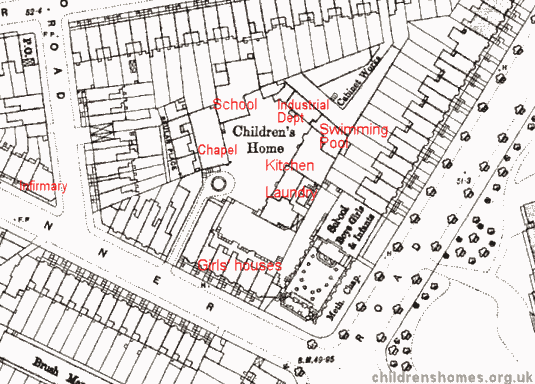
Bonner Road site, Bethnal Green, c.1895.

Children outside National Children's Home, Bonner Road, Bethnal Green, c.1900. © Peter Higginbotham

First residents of National Children's Home, Bonner Road, Bethnal Green, 1871. © Peter Higginbotham
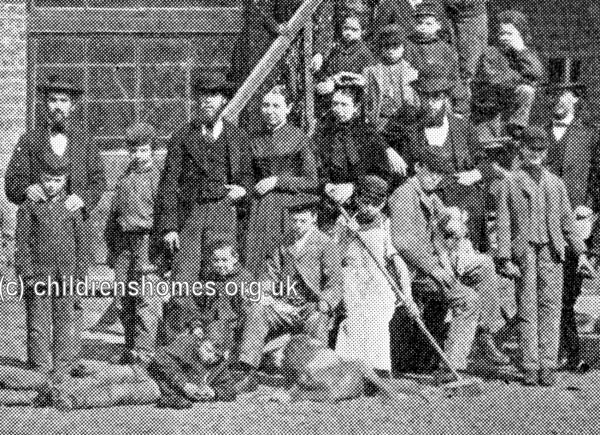
First residents of National Children's Home (detail), Bonner Road, Bethnal Green, 1871. © Peter Higginbotham
The home occupied a row of houses along the north side of Bonner Road and, to their rear, an enclosure which had previously been a stone yard. The removal from Church Street took place at the end of June 1871, with the official opening taking place on the evening of Wednesday, 4th October. A notable visitor at the event was Dr Thomas Barnardo whose own child-saving project was already expanding at Stepney. Barnardo related the story of a destitute boy called 'Carrots' whose death had greatly influenced his work.
A description of the premises on its opening day recorded that:

Visit by Sir Charles Wakefield, National Children's Home, Bonner Road, date unknown. © Peter Higginbotham
The girls occupied the houses along Bonner Road, while the boys' houses were interspersed among other buildings around the central enclosure. On the ground floor of each house was a dining-room, a washroom and a day-room, the latter fitted with small cupboards in which the boys could store personal possessions. On the first floor was a dormitory together with the house-mother's room. Each house contained twenty-five to twenty-eight boys or girls.
The children rose at 6am, with a roll-call at 6.30. Those who were in trades then went to their workshops while the remainder performed housework. Breakfast was at 8am followed by prayers in the chapel at 6.30. There were then school lessons (or work) from 9am until dinner-time. After dinner and some time for play, school/work resumed until till 5 or 5.30pm. Evening activities included singing rehearsals, swimming in the home's own pool, occasional lectures or entertainments, and other recreations considered to be of an 'instructive' character.
The construction of a proper chapel, at the west side of the enclosure, was begun in 1876 and it had its official opening on April 26th, 1877.
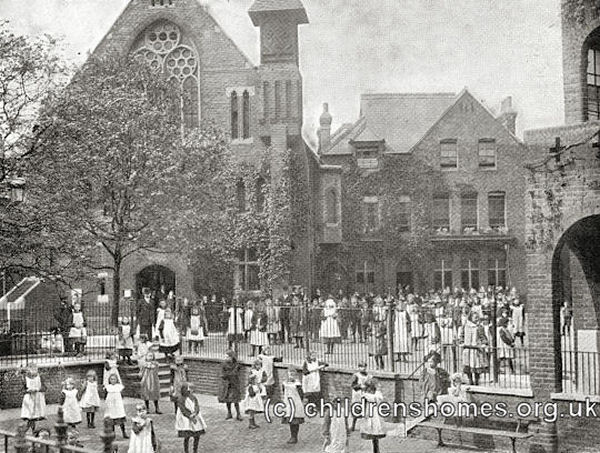
Playground and chapel, National Children's Home, Bonner Road, c.1900. © Peter Higginbotham
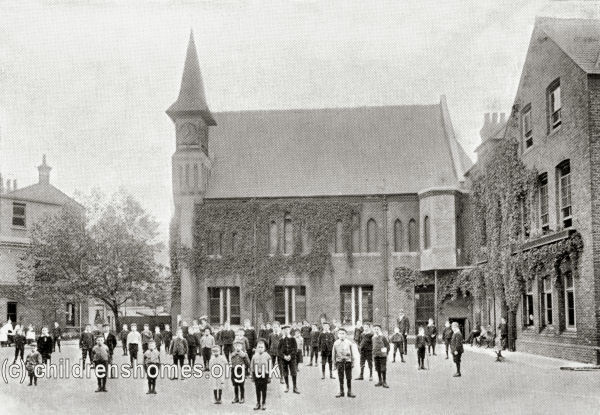
Playground and chapel, National Children's Home, Bonner Road, c.195. © Peter Higginbotham
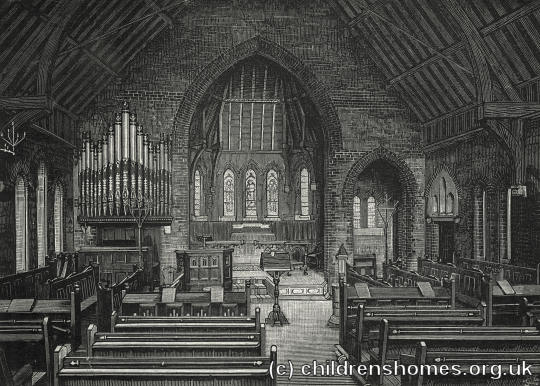
Chapel interior, National Children's Home, Bonner Road, c.1900. © Peter Higginbotham
As well as the chapel's usual daily services, there were occasional events such as funerals, and also the presentation of bibles to those children who were emigrating, with Canada being the main destination.
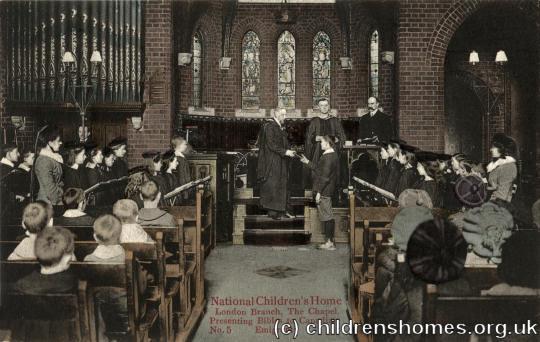
Bible presentation to emigrants, National Children's Home, Bonner Road, c.1900. © Peter Higginbotham
From 1893, children from the attended the adjacent Victoria Park Methodist Chapel for Sunday morning and evening services. The home's own chapel continued to be used for daily morning worship, Sunday afternoon services, and for sacramental and other special services.
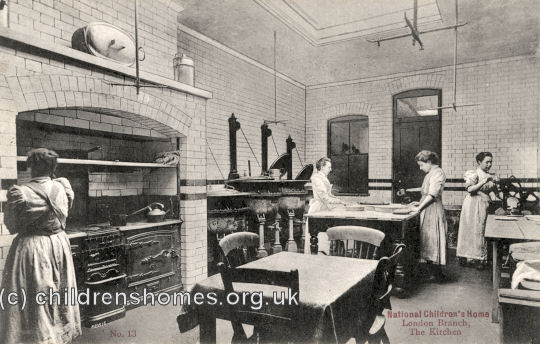
Kitchen, National Children's Home, Bonner Road, c.1911. © Peter Higginbotham

Boys' gymnastic display, National Children's Home, Bonner Road, c.1911. © Peter Higginbotham
In the industrial training department, at the northern side of the enclosure, the boys were taught skills such as carpentry, plumbing, glazing, shoe-making and baking, to help make them more employable in later life. Another major activity in this part of the part of the home was typesetting and printing. As well as items for the charity's own use, such as the Children's Home magazine, the printing office supplied external customers with a wide range of material including leaflets, periodicals, books and sheet music. Items that required folding were passed to the folding room where girls from the home performed the required operations.

Industrial training department, National Children's Home, Bonner Road, c.1900. © Peter Higginbotham
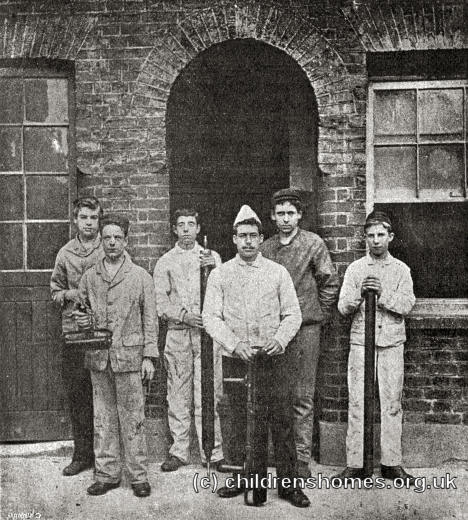
Working lads, National Children's Home, Bonner Road, c.1900. © Peter Higginbotham
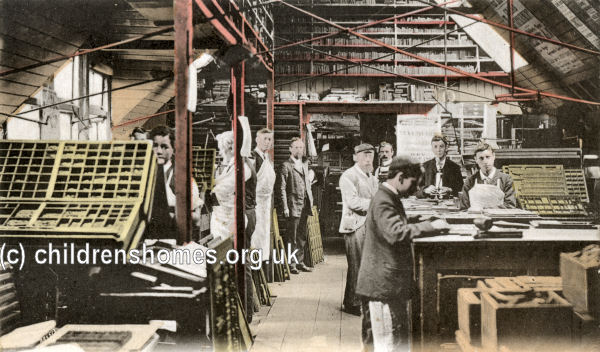
Compositors in printing department, National Children's Home, Bonner Road, early 1900s. © Peter Higginbotham
In the 1880s, a three-storey house further along Bonner Road was taken for use as an infirmary. The boys' ward was placed on the top floor, the girls' ward on the middle floor, and a convalescent ward on the ground floor.
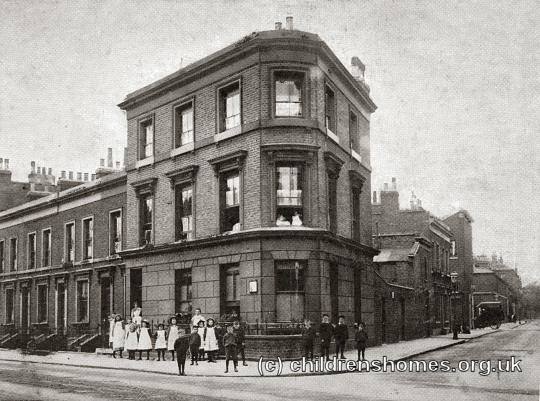
Children's infirmary, National Children's Home, Bonner Road, c.1900. © Peter Higginbotham
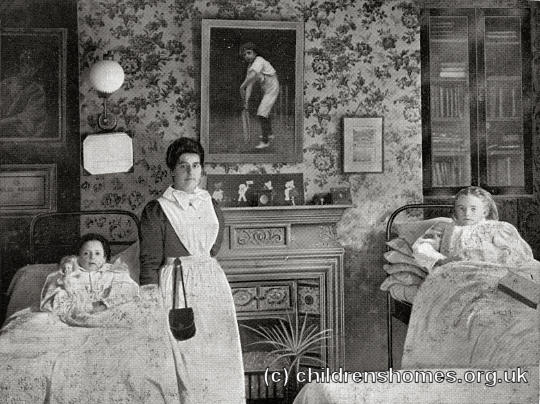
Girls' infirmary ward, National Children's Home, Bonner Road, c.1900. © Peter Higginbotham
Music formed an important part of the education at the home and a choir was formed which gave public performances.
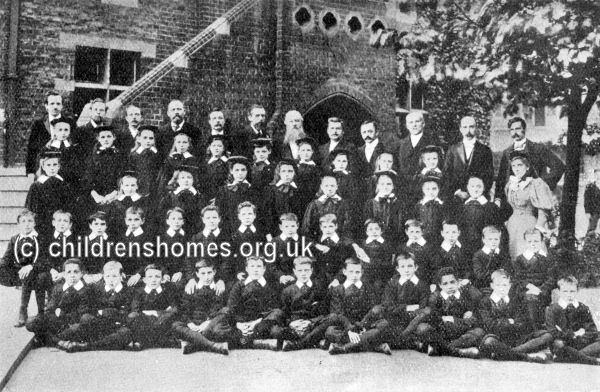
The National Children's Home Choir at Bonner Road, Bethnal Green. © Peter Higginbotham
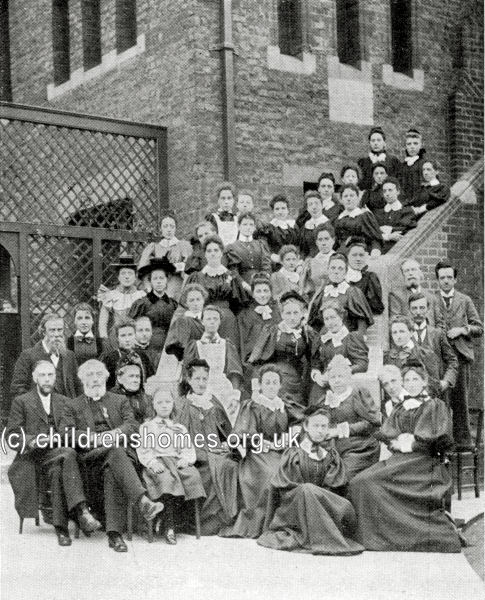
A group of officers at the National Children's Home, Bonner Road, Bethnal Green. © Peter Higginbotham
One of the home's facilities was a 'Cripples' Parlour', which provided education and other daytime facilities for disabled children in the area.
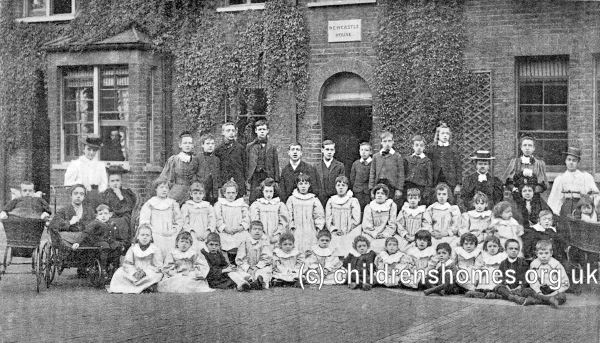
Children attending the 'Cripples' Parlour' at the National Children's Home, Bonner Road, Bethnal Green, 1899. © Peter Higginbotham
Alterations to the buildings in 1896 followed by further enlargements in 1902 took the capacity of the home to more than 300 children. The confined situation of the home made any further expansion impossible, however, and in 1913, the home and administrative headquarters were transferred to a new site at Harpenden. The Bonner Road buildings no longer survive and the St Elizabeth Catholic Primary School now occupies the site.
Records
Note: many repositories impose a closure period of up to 100 years for records identifying individuals. Before travelling a long distance, always check that the records you want to consult will be available.
- Action For Children (formerly the National Children's Home). Can provide access to their own records for individuals who were adopted through the charity or who resided in one of its homes. Help also for those searching for family history information.
Census
Bibliography
- Bradfield, William The Life of the Reverend Thomas Bowman Stephenson (1913, Kelly)
- Curnock, Nehemiah The Story of the Children's Home (C.H. Kelly, 1901)
- Higginbotham, Peter Children's Homes: A History of Institutional Care for Britain's Young (2017, Pen & Sword)
- Horner, Francis Shadow and Sun (Epworth Press, 1920)
- Howard, Philip J Philip: a Strange Child (Dalkeith Publishing, 2007)
- Philpot, Terry Action For Children (Lion, 1994)
- Walpole, Cecil F. Golden Links (Epworth Press, 1941)
Links
- Action For Children.
- Their History — a website on the homes by a former resident.
- Growing up in the NCH — a forum for those who spent time in NCH homes.
Films
- Scenes from various NCH Homes — 1960s film footage.
- NCH Documentary (1954) Part 1 — Arriving at Harpenden.
- NCH Documentary (1954) Part 2 — Harpenden Oval.
- NCH Documentary (1954) Part 3 — Annual Convocation, Alverstoke
- NCH Documentary (1954) Part 4 — Special facilities at Danesford, Chipping Norton, Harpenden and Frodsham.
- NCH Documentary (1954) Part 5 — Founders Day at Princess Alice Orphanage; training at Harpenden.
- NCH Documentary (1954) Part 6 — Harpenden.
- NCH Documentray (1964) Part 1 — Disabled and special needs at Harpenden and Chipping Norton
- NCH Documentary (1964) Part 2 — Disabled and special needs children at Harpenden, Edgworth, Chipping Norton.
- NCH Documentary (1964) Part 3 — Harpenden, Edgworth, Chipping Norton.
- NCH Documentary (1964) Part 4 — Alverstoke.
- NCH Documentary (1964) Part 5 — Alverstoke.
- NCH Documentary (1964) Part 6 — Alverstoke.
- NCH Frodsham (1960s) Part 1
- NCH Frodsham (1960s) Part 2
- NCH Brackley (1960s)
- Danesford School (1960s)
Except where indicated, this page () © Peter Higginbotham. Contents may not be reproduced without permission.


